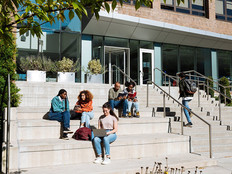2019 Tech Trends Highlight Technology Integration Opportunities for Universities
Advances in existing tools like artificial intelligence and edge computing are expected to be key focuses for 2019, according to IT analyst group Gartner’s top 10 tech trends for 2019.
“The top 10 digital technology trends are all about building the intelligent digital mesh,” says David W. Cearley, vice president and analyst for Gartner. “It’s the convergence of all of this and using it to support a continuous innovation process.”
Universities have already seen some of these tools enter the education space, with innovations such as artificial intelligence-enabled teaching assistant programs and advanced data collection and analysis to improve student performance.
As higher education institutions compete for prospective students and look to improve offerings for those on campus, technology trends on the horizon could give universities the edge they need.
MORE FROM EDTECH: See how 2019's tech trends compare to last year's forecasts!
Artificial Intelligence Will Augment Data-Driven Initiatives
Analysts expect machine learning to play an important role in 2019, offering support for tasks that may require more time, energy and training than teachers and administrators have at their disposal.
- Autonomous machines: Gartner predicts AI-enabled machines will be more common in 2019 as the technology advances and becomes commercially available. Some institutions, like Boston University, are already proposing high-tech facilities for students to experiment with autonomous machines. Other colleges are entertaining the idea of marrying AI with video content to offer more personalized learning.
- Augmented analytics: Professors and administrators rely on data analysis to get a sense of the effectiveness of a curriculum, especially as personalized learning programs become more widely adopted. Data collection and analysis has led to innovations in student assessment design, helping educators pinpoint where students are struggling and adjusting coursework to supplement those areas. Augmented analytics will help take some of the burden off users who may not be trained in data analytics, or smaller IT teams who could be more helpful putting their time somewhere else by using AI to do most of the lifting instead.
New Tools Blend the Digital and Physical Worlds
Digital transformation on college campuses is already happening at a rapid rate, and there seems to be no sign of slowing down. Analysts predict the line between the real and digital worlds will continue to blur as current technologies advance and new tools are developed.
- Digital twins: This concept is not new. Members of the online community maintain multiple versions of themselves through social media sites, online profiles and other means. Systems such as power plants have digital copies, mirroring the real thing, to monitor daily functions. This technology could be used in conjunction with AI to adapt the focus of a student’s learning to target the areas that student’s digital twin — and therefore the student — does not know yet. On a less abstract level, digital twins are also a convenient way for students to work with more accurate models of objects that would be difficult to attain or dangerous to interact with.
- Empowered edge: Edge computing takes information processing and brings it closer to the source by using edge devices instead of sending information directly to and from a centralized cloud. The next iteration, empowered edge, will use AI to diversify the kinds of devices able to act as edge endpoints, such as displays or smartphones. This could prove crucial for universities that require more computing power as they strive for a fully connected campus or integrate new tools like augmented and virtual reality headsets.
- Immersive technologies: Speaking of AR and VR, the use of immersive technology is expected to rise as hardware and software continue to improve. According to Gartner, by 2022, 70 percent of organizations will experiment with immersive technology. With 5G on the horizon promising lower latency and more robust connectivity, the quality of these tools will continue to grow, expanding their potential to supplement higher education.
Improvements in Mesh Means a Focus on How Users Engage with Tech
Universities are swiftly replacing older equipment with their next-generation versions. Previously, cork message boards were a natural part of most campuses; today, digital signage is standard. As this transition continues, universities will need to be mindful of how they design their learning environments.
- Smart Spaces: Educators are investigating connected classrooms and modern learning environments as the latest innovation in teaching, and Gartner analysts agree that smart spaces will be a major focus for 2019. Combined with other emerging tech such AI and the empowered edge, the future of the connected classroom is guaranteed.
- Digital Ethics and Privacy: The technology on Gartner’s list has the potential broaden how we incorporate technology into our lives, which means proper digital citizenship will be essential. For example, digital twins have great potential for improving learning, but such tools also require giving up valuable data and privacy to the digital universe. This means universities will need to improve curricula and resources addressing responsible technology use and online presence.
While educators have to wait to see what’s in store for 2019, the technology on Gartner’s list has the potential to change the way universities approach education and campus life.










